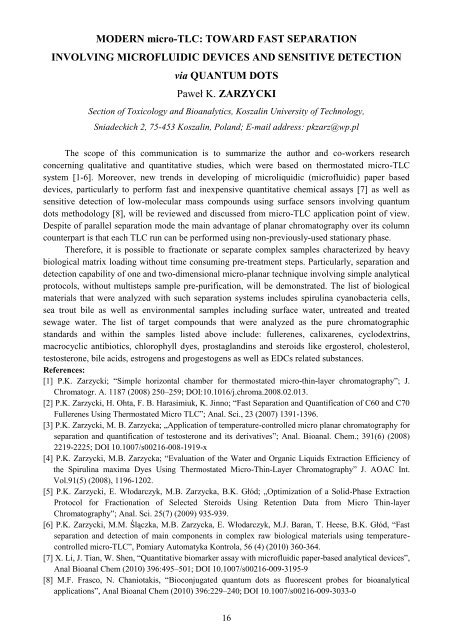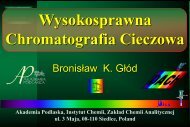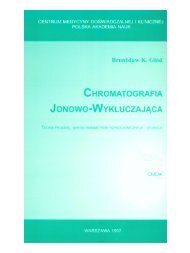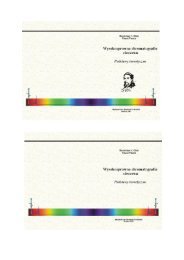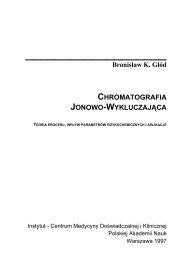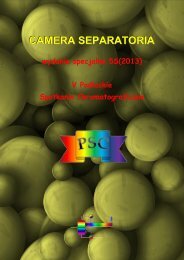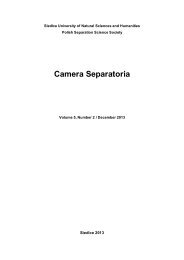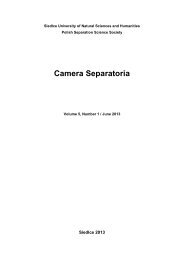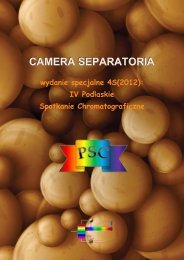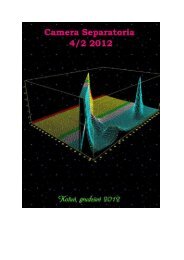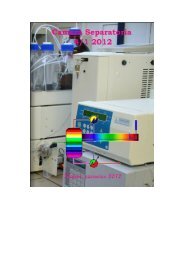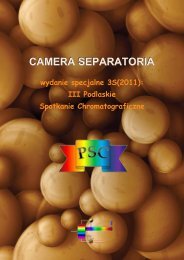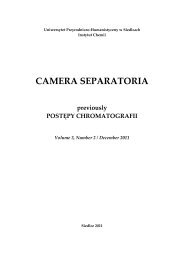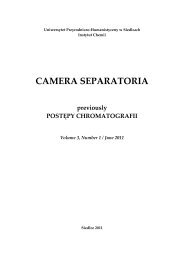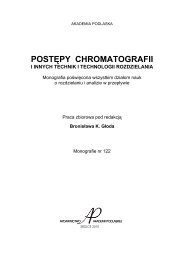CamSep 2 S
Create successful ePaper yourself
Turn your PDF publications into a flip-book with our unique Google optimized e-Paper software.
MODERN micro-TLC: TOWARD FAST SEPARATION<br />
INVOLVING MICROFLUIDIC DEVICES AND SENSITIVE DETECTION<br />
via QUANTUM DOTS<br />
Paweł K. ZARZYCKI<br />
Section of Toxicology and Bioanalytics, Koszalin University of Technology,<br />
Sniadeckich 2, 75-453 Koszalin, Poland; E-mail address: pkzarz@wp.pl<br />
The scope of this communication is to summarize the author and co-workers research<br />
concerning qualitative and quantitative studies, which were based on thermostated micro-TLC<br />
system [1-6]. Moreover, new trends in developing of microliquidic (microfluidic) paper based<br />
devices, particularly to perform fast and inexpensive quantitative chemical assays [7] as well as<br />
sensitive detection of low-molecular mass compounds using surface sensors involving quantum<br />
dots methodology [8], will be reviewed and discussed from micro-TLC application point of view.<br />
Despite of parallel separation mode the main advantage of planar chromatography over its column<br />
counterpart is that each TLC run can be performed using non-previously-used stationary phase.<br />
Therefore, it is possible to fractionate or separate complex samples characterized by heavy<br />
biological matrix loading without time consuming pre-treatment steps. Particularly, separation and<br />
detection capability of one and two-dimensional micro-planar technique involving simple analytical<br />
protocols, without multisteps sample pre-purification, will be demonstrated. The list of biological<br />
materials that were analyzed with such separation systems includes spirulina cyanobacteria cells,<br />
sea trout bile as well as environmental samples including surface water, untreated and treated<br />
sewage water. The list of target compounds that were analyzed as the pure chromatographic<br />
standards and within the samples listed above include: fullerenes, calixarenes, cyclodextrins,<br />
macrocyclic antibiotics, chlorophyll dyes, prostaglandins and steroids like ergosterol, cholesterol,<br />
testosterone, bile acids, estrogens and progestogens as well as EDCs related substances.<br />
References:<br />
[1] P.K. Zarzycki; “Simple horizontal chamber for thermostated micro-thin-layer chromatography”; J.<br />
Chromatogr. A. 1187 (2008) 250–259; DOI:10.1016/j.chroma.2008.02.013.<br />
[2] P.K. Zarzycki, H. Ohta, F. B. Harasimiuk, K. Jinno; “Fast Separation and Quantification of C60 and C70<br />
Fullerenes Using Thermostated Micro TLC”; Anal. Sci., 23 (2007) 1391-1396.<br />
[3] P.K. Zarzycki, M. B. Zarzycka; „Application of temperature-controlled micro planar chromatography for<br />
separation and quantification of testosterone and its derivatives”; Anal. Bioanal. Chem.; 391(6) (2008)<br />
2219-2225; DOI 10.1007/s00216-008-1919-x<br />
[4] P.K. Zarzycki, M.B. Zarzycka; “Evaluation of the Water and Organic Liquids Extraction Efficiency of<br />
the Spirulina maxima Dyes Using Thermostated Micro-Thin-Layer Chromatography” J. AOAC Int.<br />
Vol.91(5) (2008), 1196-1202.<br />
[5] P.K. Zarzycki, E. Włodarczyk, M.B. Zarzycka, B.K. Głód; „Optimization of a Solid-Phase Extraction<br />
Protocol for Fractionation of Selected Steroids Using Retention Data from Micro Thin-layer<br />
Chromatography”; Anal. Sci. 25(7) (2009) 935-939.<br />
[6] P.K. Zarzycki, M.M. Ślączka, M.B. Zarzycka, E. Włodarczyk, M.J. Baran, T. Heese, B.K. Głód, “Fast<br />
separation and detection of main components in complex raw biological materials using temperaturecontrolled<br />
micro-TLC”, Pomiary Automatyka Kontrola, 56 (4) (2010) 360-364.<br />
[7] X. Li, J. Tian, W. Shen, “Quantitative biomarker assay with microfluidic paper-based analytical devices”,<br />
Anal Bioanal Chem (2010) 396:495–501; DOI 10.1007/s00216-009-3195-9<br />
[8] M.F. Frasco, N. Chaniotakis, “Bioconjugated quantum dots as fluorescent probes for bioanalytical<br />
applications”, Anal Bioanal Chem (2010) 396:229–240; DOI 10.1007/s00216-009-3033-0<br />
16


